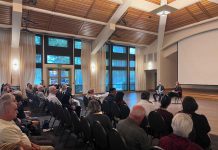It’s silly season again in California. For the sixth time in the
last 25 years or so, a politician is suggesting the state needs to
be split.
It’s silly season again in California. For the sixth time in the last 25 years or so, a politician is suggesting the state needs to be split.
The interesting thing is that while the first four such fairly recent attempts involved a north-south divide roughly at the ridge atop the Tehachapi Mountains between Los Angeles and Bakersfield, the two most recent ones advocate roughly an east-west, inland-coastal split, with San Diego and Orange counties tacked onto the eastern, inland portion.
The latest secession proposal comes from Riverside County Supervisor Jeff Stone, a Republican previously best known for his fervent defense of since-discredited and -disallowed electronic voting machines.
Stone wants to take his own county, along with the counties of Imperial, San Bernardino, Orange, San Diego, Kings, Kern, Fresno, Tulare, Inyo, Madera, Mariposa and Mono out of California and form a new state, which he tentatively dubs “South California.”
The last successful split of this sort came in the Civil War era, when West Virginia was formed as a pro-Union state after the rest of Virginia joined the Confederacy.
Californians may be divided today, but feelings can’t begin to compare with that era. So why does Stone want out of the current California?
“We have a state Legislature that has gone wild,” he told a reporter just after the new state budget was approved in late June. “They just don’t care. Their goal was to get a balanced budget so they could continue to get a paycheck. There is only one solution: A serious secession from the liberal arm of the state of California.”
It’s that last sentence that reveals the most about Stone’s proposal and the previous one that came just two years ago from termed out Republican Assemblyman Bill Maze of Visalia (Maze also proposed an east-west split, with San Diego and Orange Counties included, but his quickly-ignored plan had the new state extending all the way to the Oregon state line).
In both cases, the demographic makeup of the new state would assure election of a Republican governor, mostly Republican legislators and two Republican U.S. senators.
So this can be seen as a move by disgruntled Republicans who have failed repeatedly to register anywhere near as many California voters as the rival Democrats.
They’re tired of being outgunned politically by the state’s two big coastal population centers around Los Angeles and San Francisco. Stone and Maze might also be interested in becoming statewide officials in a new jurisdiction, since neither has a realistic hope of achieving that in the current California.
In the sense that they both fear and abhor political domination by the other folks who make up at least the state’s plurality, the latest state-split sponsors have something in common with the 27 state-split efforts that preceded theirs over the last century.
All those efforts to separate Northern California played on fears that Southern California’s greater population would eventually leave the north state little voice in its own affairs. Of course, things have not worked out that way. Both the state’s longtime U.S. senators, Barbara Boxer and Dianne Feinstein, are former San Francisco Bay area officials, even though Boxer now lives in Rancho Mirage, within Stone’s own Riverside County.
The governor is an Oakland resident and former mayor. The last three presidents of the state Senate have hailed from Northern California. The lieutenant governor and attorney general are both former top San Francisco officials. What Southern California dominance? In fact, an argument could be made that Southern California is woefully underrepresented among top state officeholders.
The latest proposals also ignore reality: No new state could arise without an overall yes vote of all Californians, something that’s not very likely. Plus, Congress would have to give its OK. Also not likely with a Democratic majority in the U.S. Senate. There’s also the fact that small-state senators would see their clout diluted if California in effect got two more senators. And rural states might not like giving two new Senate seats to what would in fact be a largely urban new state, including sizeable cities like San Diego, Santa Ana, Fresno, Riverside, Bakersfield and San Bernardino.
These realities don’t faze the likes of Stone and Maze, who complained when introducing his own proposal in 2009 that too many radical social ideas percolate inland from the coastal counties he sought to get rid of.
“We certainly can no longer overlook the radical-thinking paradigms that have invaded California, particularly in the last two decades,” Maze said then.His idea drew more ridicule than support, which was probably appropriate. Stone’s fatuous notion deserves similar treatment.
Email Thomas Elias at td*****@*ol.com. His book, “The Burzynski Breakthrough: The Most Promising Cancer Treatment and the Government’s Campaign to Squelch It,” is available in a fourth edition. For more columns, visit www.californiafocus.net.







